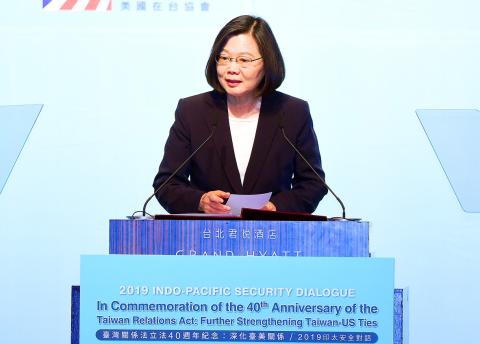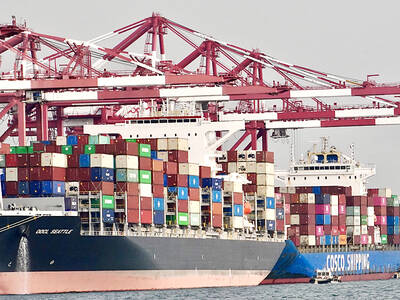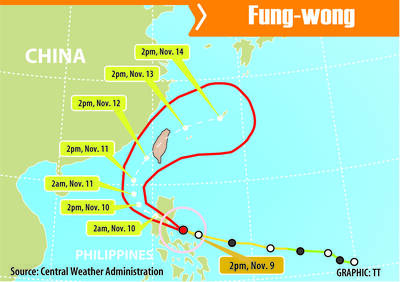Taiwan has not been intimidated by China’s military drills this week, President Tsai Ing-wen (蔡英文) said yesterday, while a senior US official denounced the latest Chinese maneuvers as “coercion” and a threat to regional stability.
Tsai said Taiwan was resolute in its defense.
“China’s armed forces yesterday [Monday] sent a large number of military aircraft and naval vessels into our vicinity. Their actions threaten Taiwan and other like-minded countries in the region,” Tsai said at a forum cohosted by the Ministry of Foreign Affairs to mark the 40th anniversary of the US’ Taiwan Relations Act.

Photo: Liao Chen-huei, Taipei Times
The event was attended by a delegation led by former US House of Representatives speaker Paul Ryan.
“These actions only serve to strengthen our resolve. Our military forces have the capacity, determination and commitment to defend Taiwan and not allow coercion to dictate our own future,” Tsai said.
She also said that US President Donald Trump’s administration had notified Taipei that its pilots could continue training at the Luke Air Force Base in Arizona.
“It enhances their abilities to defend our airspace. I want to express my appreciation to the US government for the announcement,” she said.
Taiwan scrambled jets and ships to monitor the Chinese forces on Monday, the Ministry of National Defense said, accusing Beijing of “trying to change the ‘status quo’ of the Taiwan Strait.”
China’s Taiwan Affairs Office said that Taipei was seeking to “slander” China and mislead the public with its criticism of the exercises to provoke confrontation.
“No person or any force should underestimate our firm determination and strong ability to defend the country’s sovereignty and territorial integrity,” it said.
The People’s Liberation Army Daily said the goal of the drills was to practice a “combined firepower assault” that included electronic jamming from aircraft under the protection of fighter jets.
Bombers “screamed” toward the area and carried out “sudden attacks,” while warships occupied assault positions and conducted attacks on enemy fire points, the official paper of China’s military said.
Landing forces reached specified waters, which were circled by helicopters at low altitude.
The paper cited a Chinese military representative as saying the exercises were held annually and “completely within the normal legal rights of a sovereign country.”
China has repeatedly carried out what it calls “island encirclement patrols” in the past few years.
Ryan said that the US considered any military threat to Taiwan a concern and urged China to stop, saying it was counterproductive.
“I urge Beijing to choose the path of peace, respect, and civility by resuming dialogue with Taiwan’s democratically elected administration,” he said.
Tsai said she wants to maintain the “status quo” with China, but would defend Taiwan’s security and democracy.
The visit by US officials comes weeks after Tsai said the US was responding positively to Taipei’s requests for new arms sales to bolster its defenses in the face of growing pressure from China.

The Central Weather Administration (CWA) yesterday said it expected to issue a sea warning for Typhoon Fung-Wong tomorrow, which it said would possibly make landfall near central Taiwan. As of 2am yesterday, Fung-Wong was about 1,760km southeast of Oluanpi (鵝鑾鼻), Taiwan’s southernmost point, moving west-northwest at 26kph. It is forecast to reach Luzon in the northern Philippines by tomorrow, the CWA said. After entering the South China Sea, Typhoon Fung-Wong is likely to turn northward toward Taiwan, CWA forecaster Chang Chun-yao (張峻堯) said, adding that it would likely make landfall near central Taiwan. The CWA expects to issue a land

Taiwan’s exports soared to an all-time high of US$61.8 billion last month, surging 49.7 percent from a year earlier, as the global frenzy for artificial intelligence (AI) applications and new consumer electronics powered shipments of high-tech goods, the Ministry of Finance said yesterday. It was the first time exports had exceeded the US$60 billion mark, fueled by the global boom in AI development that has significantly boosted Taiwanese companies across the international supply chain, Department of Statistics Director-General Beatrice Tsai (蔡美娜) told a media briefing. “There is a consensus among major AI players that the upcycle is still in its early stage,”

The Central Weather Administration (CWA) yesterday said it is expected to issue a sea warning for Typhoon Fung-wong this afternoon and a land warning tomorrow. As of 1pm, the storm was about 1,070km southeast of Oluanpi (鵝鑾鼻), Taiwan’s southernmost point, and was moving west-northwest at 28 to 32kph, according to CWA data. The storm had a radius of 250km, with maximum sustained winds of 173kph and gusts reaching 209kph, the CWA added. The storm is forecast to pass near Luzon in the Philippines before entering the South China Sea and potentially turning northward toward Taiwan, the CWA said. CWA forecaster Chang Chun-yao (張峻堯) said

Japanese Prime Minister Sanae Takaichi yesterday said that China using armed force against Taiwan could constitute a "survival-threatening situation" for Japan, allowing the country to mobilize the Japanese armed forces under its security laws. Takaichi made the remarks during a parliamentary session while responding to a question about whether a "Taiwan contingency" involving a Chinese naval blockade would qualify as a "survival-threatening situation" for Japan, according to a report by Japan’s Asahi Shimbun. "If warships are used and other armed actions are involved, I believe this could constitute a survival-threatening situation," Takaichi was quoted as saying in the report. Under Japan’s security legislation,